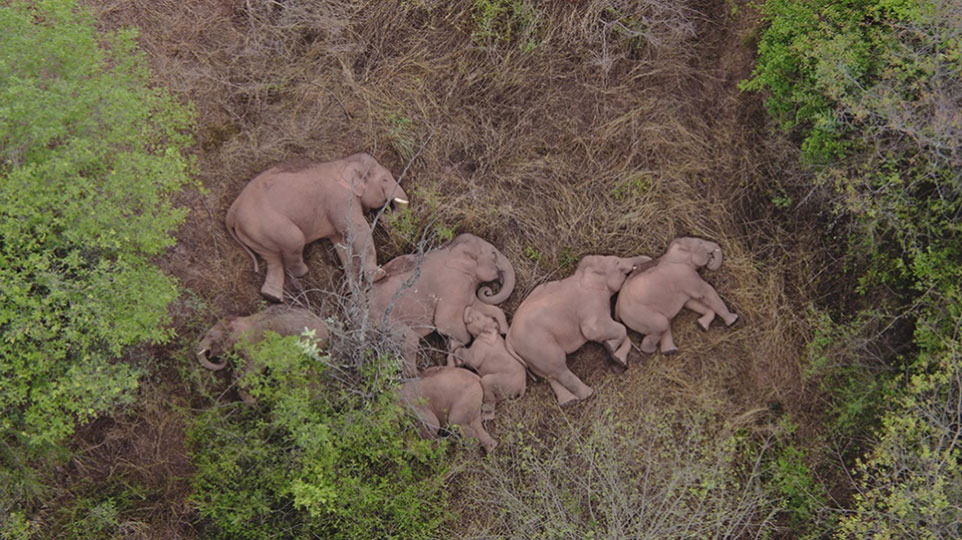
China is not famous for its elephants — but the famed wandering herd has been dominating animal media headlines for some while.
The whole herd of 15 animals originally left a wildlife reserve in the southwest of Yunnan province more than a year ago. They trekked over 300 miles (500km) north, arriving at the outskirts of the provincial capital of Kunming.
Last week the elephants were on the move again, heading southwest while a male who broke from the herd is 10 miles (16km) away, still on the outskirts of Kunming.
Despite authorities and elephant experts blocking routes and tempting the animals with sweet nibbles, the herd of 15 have raided farms, strolled down urban streets, and foraged for snacks in villages and even a retirement home.
All the elephants seem healthy and no humans have been injured in encounters with them.
China has roughly 300 wild elephants and they are highly legally protected, enjoying the same protection as China’s unofficial mascot, the giant panda.
Extra precautions are being taken around local Dragon Boat festivals this week. Crowds of onlookers expected for the festivals and emergency workers, vehicles, and drones will be looking out for the elephants.
These teams are monitoring the elephants’ movements as well as protecting local residents. Two-and-a-half tons of food was laid out for the animals before last weekend.
Nobody knows why this band of adventurous pachyderms embarked on their epic trek. Some reasons suggested have included lack of food supply, a rise in population, and, most likely, loss of habitat.
Those are exactly the same threats that elephants are facing all across the globe. We have long known they were under threat and being hunted by ivory poachers as well as the destruction of habitat by agriculture and development.
Now a newly published report from the International Union for the Conservation of Nature (IUCN) reveals African forest elephants are now critically endangered. Savanna elephants are also under threat.
The report tells us that the elephant is in far more danger than we previously thought. Unless we take very urgent action, elephants will become extinct.
At least 20,000 elephants are killed in Africa each year for their tusks. African forest elephants are the worst hit.
Their populations declined by 62 percent between 2002 and 2011 and they have lost a third of their geographical range, with African savanna elephants declining by 30 percent between 2007 and 2014.
This dramatic decline has continued and even accelerated with cumulative losses of up to 90 percent in some locations between 2011 and 2015.
Today, the greatest threat to African elephants is ivory poaching, while the greatest threat to Asian elephants is habitat loss, which has resulted in some tragic and often headline grabbing human-elephant clashes.
Elephants have attacked — sometimes fatally — those trying to exclude them from the countryside that they have grazed for years. The African elephant is the largest of all elephant species and weighs up to eight tons.
All African elephants were long considered to be a single species but in the last decade research discovered that there are actually two genetically different African subspecies.
One is the savanna elephant (Loxodonta africana) and the other the forest elephant (Loxodonta cyclotis), with a number of characteristics that differentiate them both.
Asian elephants (Elephas maximus) are smaller than their African cousins, and their ears are smaller compared to the large fan-shaped ears of the African species.
While both male and female African elephants grow tusks, only some male Asian elephants have them.
Elephants live in complex social structures of females and calves led by a matriarch. Male elephants usually live in isolation or in small bachelor groups.
A single calf is born to a female once every four to five years and after a gestation period of 22 months — the longest of any mammal.
Calves are cared for by the entire herd of related females. Female calves may stay with their maternal herd for the rest of their lives. Males leave the herd as they reach puberty.
Elephants need massive land areas to survive and meet their needs for food, water, and space. On average, an elephant can feed for up to 18 hours and consume hundreds of pounds of vegetable matter in a single day. This can often result in conflict with humans cultivating crops.
The seeds of many plant species, including a third of all trees, in both African and Asian forests, need to pass through an elephant’s digestive tract before they can germinate.
Ironically it is China that is still by far the largest market for poached elephant ivory. It banned the domestic trade in elephant ivory as of January 1, 2018. Since then, Chinese consumer desire for elephant ivory has dropped and wholesale prices, even on the black market, have fallen.
The latest report reveals that the ivory trade, loss of vital habitat, and a deeper understanding of elephant biology have all combined to reveal a previously underestimated threat to Africa’s elephants. It estimates that only 415,000 elephants remain in Africa, far less than was previously estimated.
While poaching for ivory remains one of the major causes of the decline, there is another silent killer — land degradation and fragmentation. It is a big challenge for an animal species that requires very large areas and that roam over long distances.
On a personal note, a few years ago I was invited to South Africa to give some help to the new ANC Ministry of Tourism on how to attract visitors to that beautiful country.
Among the places I visited was Addo Elephant Park in Nelson Mandela Bay. Addo is the third-largest national park in South Africa, with spectacular wildlife including well over 600 wild elephants. It was wonderful to live alongside the huge beasts for a few days in a place they were safe from poaching or losing the landscape they flourished in.
The elephants I saw at Addo have small or no tusks. Over the years this made them less attractive to poachers who tended to hunt down the bigger tuskers. The result was that small-tusked animals become dominant. This isn’t natural selection but selection by illegal slaughter. Today poaching is much better controlled and elephant numbers in Addo are increasing.
While in Addo Elephant park I discovered the fist-sized flightless elephant dung beetle — truly as remarkable as elephants themselves. These dung beetles have adapted to feed on elephant poo. They eat fresh dung where it drops or roll it into a ball and bury it for later. Up to 16,000 huge beetles will be recycling a single steaming elephant dung pile.
We all need to take urgent and drastic action if our three living elephant species don’t join their close relative the mammoth in extinction.
Unless we halt the decline and stop the murderous slaughter for ivory, unless we learn to live with the elephant in both Africa and Asia, they may become totally extinct.
Can we really tolerate a situation where our great-grandchildren will never see a live elephant?










